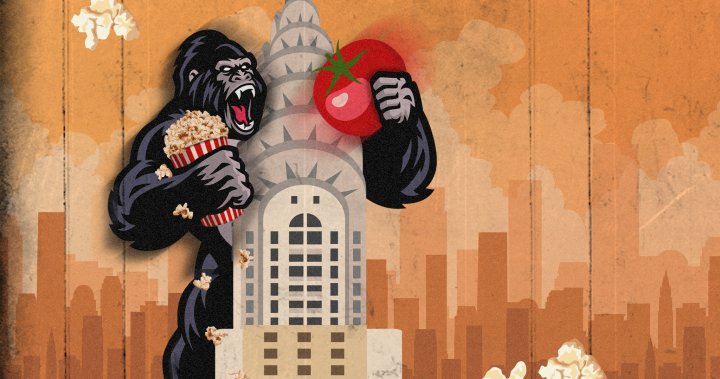
Moviegoers were left scratching their heads this spring when Paddington 2, a children’s film about an anthropomorphic bear, overtook Citizen Kane on Rotten Tomatoes, cementing the sequel’s status as one of the best-reviewed films on the site.
It seems to be a trend on Rotten Tomatoes; movie review scores on the site have been creeping upward for a decade, according to data compiled by Global News.
Films on Rotten Tomatoes are given a “Tomatometer†score out of 100 per cent, based on how many critics give the film a positive review.
By 2019, that average score had climbed to a high of 62 per cent — an important milestone, since 60 per cent is the dividing line between a “fresh†film and a “rotten†one.
Effectively, the average movie has gone from rotten to fresh in just 10 years.
This spring’s Godzilla vs Kong, a movie about a giant CGI ape brought out of retirement to battle a giant CGI lizard, had a score of 79 per cent in the lead-up to its opening weekend (it has since dropped to 76 per cent).
The rising scores come as Rotten Tomatoes has forged close financial ties with the movie industry.
And in 2016, Comcast (which also owns NBCUniversal) acquired a 70 per cent stake through a deal that turned Rotten Tomatoes into a division of the ticket vendor Fandango.
“If you’re certified fresh on Rotten Tomatoes, that’s definitely something that you’re going to pull into your campaign,†says Andréa Grau, founder and owner of the publicity firm Touchwood PR.
For Meares, it’s not clear how Rotten Tomatoes or its corporate owners could influence the scores that films receive.
But exactly how film reviews are classified as rotten or fresh has never been an exact science.
“It’s this weird Wild West about what counts as fresh or rotten,†says Jason Gorber, a Toronto-based freelance film critic with reviews on the site dating back over two decades.
Roughly half of all reviews added to Rotten Tomatoes are self-submitted, which means that the critic or publication specifies whether their review is fresh or rotten, using whatever criteria they like.
Still, other critics, Gorber says, “have never logged into Rotten Tomatoes at all.â€.
For these critics, the company employs a team of curators, seven in all, who read hundreds of reviews a week and mark them fresh or rotten based on their interpretation.
When Rotten Tomatoes started in the late-1990s, most professional film critics worked as full-time tenured employees at large publications.
Looking at the top 100 films in 2017, a USC Annenberg report found that 82 per cent of the reviews on Rotten Tomatoes were written by white critics, and 78 per cent by men.
“When I’m on the fence about a film and haven’t seen it yet, the last thing I want to do is read 80 reviews from old white men,†Solzman says.
More critics on the site have meant more movie reviews contributing to each film’s score.
If you are feeling particularly studious and want to browse the 541 reviews that makeup Avengers: Endgame’s 94 per cent rating, you’ll notice that many of the critics hail from niche online publications that cater to specific audiences.
Meares thinks the growth of internet critics writing for specific audiences could potentially help explain rising Rotten Tomatoes scores.
Global News also looked at average movie review scores for wide releases on Metacritic, a competing online review aggregator, and IMDb, an online database of movie and TV info.
Films regularly score lower on Metacritic now than they do on Rotten Tomatoes.
This spring’s Quiet Place Part II is currently at 91 per cent on Rotten Tomatoes but only 71 on Metacritic.
On Rotten Tomatoes, by contrast, the Tomatometer score is nothing more than the percentage of critics who thought the film was worth seeing.
Since Global News conducted analysis independently, Meares of Rotten Tomatoes says it’s hard to comment authoritatively on our findings.
People often assume that if a film is at “80 per cent on Rotten Tomatoes that means it’s an A movie, and if it’s 70 per cent that means it’s a B movie
“Some of the greatest films ever made are 50 per cent on Rotten Tomatoes, because half the audience really loved it and half the audience hated it
On the other hand, he notes that a mediocre movie can easily score 80 per cent or 90 per cent on the platform, if most of the critics who viewed the film thought it was just fine
He believes that Rotten Tomatoes is best used as a jumping-off point for exploring the criticism, discussion, and debate around a film
“If you are deciding not to not watch a film because of its negative Rotten Tomatoes score, I highly encourage you to look and read some of those negative reviews (or at least scan them before worrying about spoilers) and decide to engage with the conversation, rather than simply dismiss it.â€
Global News downloaded every available film review score since the dawn of cinema from Rotten Tomatoes, Metacritic, and IMDB using the OMDb API